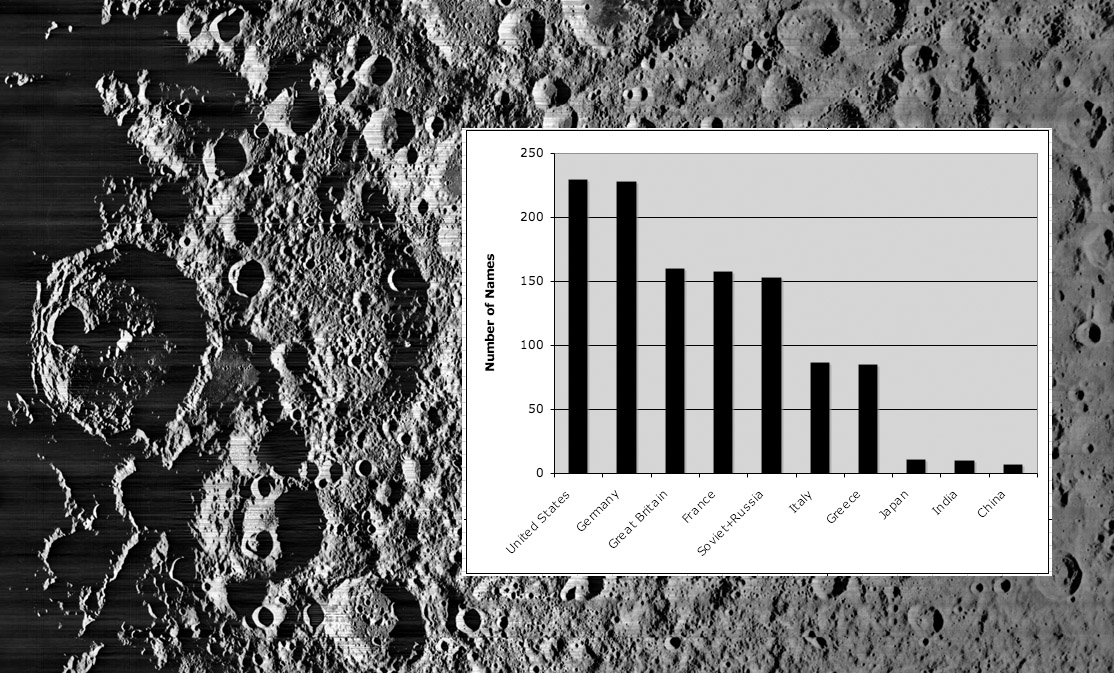|
|
| Line 1: |
Line 1: |
| | __NOTOC__ | | __NOTOC__ |
| | =The Coming Lunar Name-Rush= | | =The Coming Lunar Name-Rush= |
| | + | <div class="post" id="post-1623"> |
| | | | |
| − |
| + | <div class="storycontent"> |
| − | <div class="post" id="post-1623">
| + | <p>[[File:I-116LPOD.jpg|i-116LPOD.jpg]]<br /> |
| − |
| |
| − | <div class="storycontent">
| |
| − | <p>[[File:I-116LPOD.jpg|i-116LPOD.jpg]]<br />
| |
| | <em>Lunar Orbiter I-116 image from[http://www.lpi.usra.edu/resources/lunarorbiter/frame/?1116 LPI Lunar Orbiter Photo Gallery]. None of the nations between Greece and Japan are plotted.</em></p> | | <em>Lunar Orbiter I-116 image from[http://www.lpi.usra.edu/resources/lunarorbiter/frame/?1116 LPI Lunar Orbiter Photo Gallery]. None of the nations between Greece and Japan are plotted.</em></p> |
| | <p>Of the 1568 named craters in the IAU [http://planetarynames.wr.usgs.gov/jsp/FeatureTypesData2.jsp?systemID=3&bodyID=11&typeID=9&system=Earth&body=Moon&type=Crater,%20craters&sort=AName&show=Fname&show=Lat&show=Long&show=Diam&show=Stat&show=Orig list] of lunar nomenclature, 72% are named for people from just 7 countries. This results from the history of lunar mapping and exploration. 230 craters are named for individuals associated with the United States, including many foreign born scientists (e.g. Einstein) who worked in the USA. 153 names are from Russia and the Soviet Union. I assume that the abundance of these American and Russian names reflects the triumphs of those countries in lunar exploration. There are 546 craters named for people from Germany, England and France, because these nations (especially the first two) led in lunar mapping in the 1800s. And Italy and Greece have 172 named craters, representing the earliest period of lunar map making in the 1600s when names were given to dead Greeks and alive Italians. 439 named craters commemorate people from 45 other nations, predominantly European. Today, spacecraft from Japan and China orbit the Moon and they will be joined by one from India next year. These nations will demand that many of their country men and women be honored with names on lunar craters. Mostly, I hope, these names will be assigned to farside craters, where currently there are only [http://the-moon.wikispaces.com/Nomenclature+Zoo 677] names, compared to 1229 for the nearside. But it also needs to be pointed out that there was no rush to add more American names after Clementine and Lunar Prospector, nor - so far - following SMART-1. Perhaps, there won’t be a lunar name-rush, but I doubt it.</p> | | <p>Of the 1568 named craters in the IAU [http://planetarynames.wr.usgs.gov/jsp/FeatureTypesData2.jsp?systemID=3&bodyID=11&typeID=9&system=Earth&body=Moon&type=Crater,%20craters&sort=AName&show=Fname&show=Lat&show=Long&show=Diam&show=Stat&show=Orig list] of lunar nomenclature, 72% are named for people from just 7 countries. This results from the history of lunar mapping and exploration. 230 craters are named for individuals associated with the United States, including many foreign born scientists (e.g. Einstein) who worked in the USA. 153 names are from Russia and the Soviet Union. I assume that the abundance of these American and Russian names reflects the triumphs of those countries in lunar exploration. There are 546 craters named for people from Germany, England and France, because these nations (especially the first two) led in lunar mapping in the 1800s. And Italy and Greece have 172 named craters, representing the earliest period of lunar map making in the 1600s when names were given to dead Greeks and alive Italians. 439 named craters commemorate people from 45 other nations, predominantly European. Today, spacecraft from Japan and China orbit the Moon and they will be joined by one from India next year. These nations will demand that many of their country men and women be honored with names on lunar craters. Mostly, I hope, these names will be assigned to farside craters, where currently there are only [http://the-moon.wikispaces.com/Nomenclature+Zoo 677] names, compared to 1229 for the nearside. But it also needs to be pointed out that there was no rush to add more American names after Clementine and Lunar Prospector, nor - so far - following SMART-1. Perhaps, there won’t be a lunar name-rush, but I doubt it.</p> |
| Line 13: |
Line 11: |
| | See the national origin of all lunar names (not just crater names) at The Moon Wiki [http://the-moon.wikispaces.com/Nomenclature-Country page] created by Mark Tillotson. </p> | | See the national origin of all lunar names (not just crater names) at The Moon Wiki [http://the-moon.wikispaces.com/Nomenclature-Country page] created by Mark Tillotson. </p> |
| | <p align="center"><em>Its too late for Christmas buying, but not to support LPOD when you buy anything from Amazon thru [http://www.lpod.org/?page_id=591 LPOD!]</em></p> | | <p align="center"><em>Its too late for Christmas buying, but not to support LPOD when you buy anything from Amazon thru [http://www.lpod.org/?page_id=591 LPOD!]</em></p> |
| − | </div>
| + | </div> |
| − |
| |
| − | | |
| | ---- | | ---- |
| | ===COMMENTS?=== | | ===COMMENTS?=== |
| | Click on this icon [[image:PostIcon.jpg]] at the upper right to post a comment. | | Click on this icon [[image:PostIcon.jpg]] at the upper right to post a comment. |




